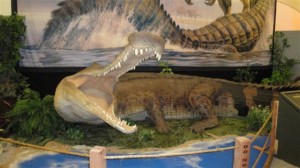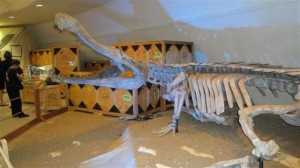The Natural History Museum in London has recently become the proud owner of the largest piece of the Tissint Martian meteorite. The new addition is now the largest piece of meteorite held in the prestigious museum, weighing in at 1.1kg. The museum is delighted with the donation, but do not know who to thank because the donor has decided to stay anonymous. The piece of meteorite would not have come cheap, and is thought to have cost much more than a Mediterranean cruise or a flashy new sports car.
Scientists hope to find answers to questions about the Red Planet, like what its atmosphere used to be like and whether life could have once flourished on the planet. Dr. Caroline Smith works at the Natural History Museum, and has said the Tissint meteorite is the, “most important meteorite to have landed on Planet Earth in the last 100 years”.
How the Martian Meteorite Ended up at the Natural Science Museum
Last year in July, eyewitnesses in Morocco heard two loud sonic booms as a bright light sped towards the ground leaving a distinctive trail behind it. That bright light was a meteorite, which entered Earth’s atmosphere and broke up into smaller pieces before landing in a desert in southern Morocco. The pieces of rare Martian meteorite, called Tissint, were quickly searched for and collected up before the Earth’s atmosphere could contaminate them too much.
A man named Darryl Pitt, of the Macovich Collection in New York City, heard about the meteorite landing and set out to track a piece down. Rumors spread about it being retrieved and Mr. Pitt frantically searched for people possessing the alien rock. He almost gave up his quest, but then a phone call out of the blue lead him straight to the largest piece recovered. Mr. Pitt purchased the meteorite on behalf of an anonymous benefactor and then donated it to the Natural History Museum in London.
Details of how much the rare space rock actually cost have not been revealed, and the donor wishes for their identity to be kept private. But a spokesperson from Sotheby’s auction house in London has said that meteorites had previously sold for sums between £10,000 and £20,000, but the origin of the meteorite makes a lot of difference, as does its size. It might be the case that the Martian meteorite in question reached a price similar to the Moon Rock sold at Sotheby’s in 1993, which reached a staggering £250,000.
Why the Tissint meteorite is so rare
There have only been four recorded meteorites from Mars landing on Earth, and the last most recent one landing in Nigeria 50 years ago, in 1962. The three other occasions where in 1911, 1865, and 1815. In the last fifty years technology has developed so rapidly that there are new ways to analyze Martian rock, and scientists are excited at the prospect of studying a piece of the Tissint meteorite. Another reason that this particular meteorite is significant compared to earlier landings is the short amount of time between landing and collection. They landed in a dry area of desert, so contamination from the earth’s environment and organisms has been minimal.
Out of the 41,000 known meteorites in the global science community, only 61 of them originate from Mars, only 0.15% of all meteorites. Material from Mars has never been able to be transported back to Earth by human efforts, although this may happen in the next decade. Even so, the process of collecting rocks from Mars and bringing them back here would costs billions of dollars. So having them blasted from the surface of Mars and land on Earth is much easier, but it doesn’t happen often.
What scientists hope to find out from the meteorite
It has already been estimated that the Tissint meteorite was ejected from the surface of Mars approximately 600,000 to 17 million years ago. Scientists hope to be able to glean information about the history of the Red Planet, and maybe gain evidence on whether life existed on Mars in the past.
Further analysis will look at the exact chemistry of the rock, to see what elements it is made of. In particular they will see if any minerals that form when water is present are in the rock, and if it contains molecules rich in carbon. If these things are found, they would provide evidence that there once was life on Mars.
Knowing exactly what secrets the rock holds about the planet nearest to earth is some time away at the moment, but the investigation has begun. Let’s hope this donation inspires other people to help science unravel the many mysteries of the universe.

